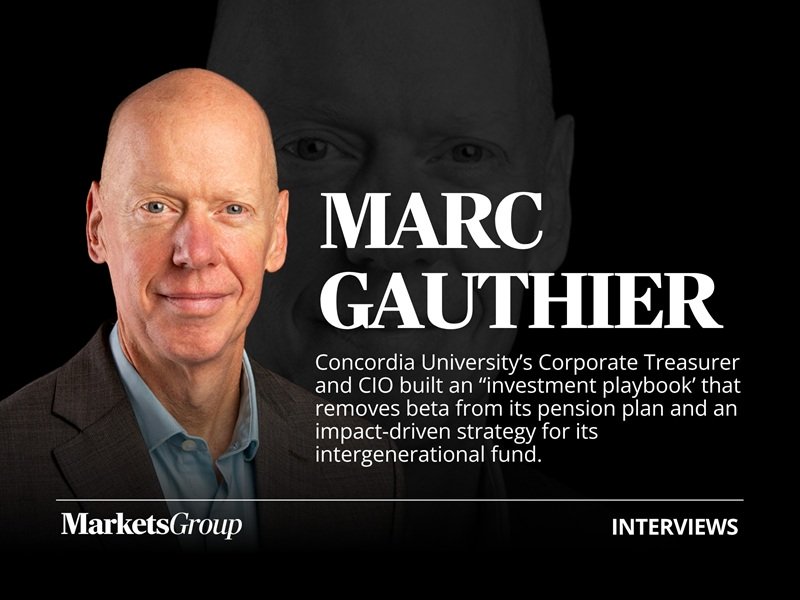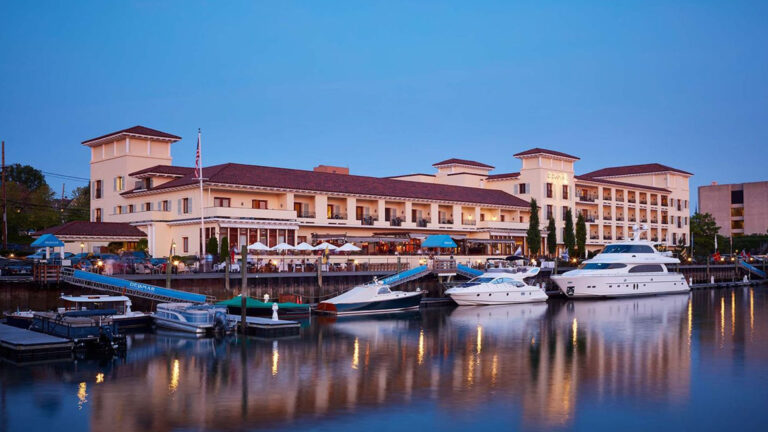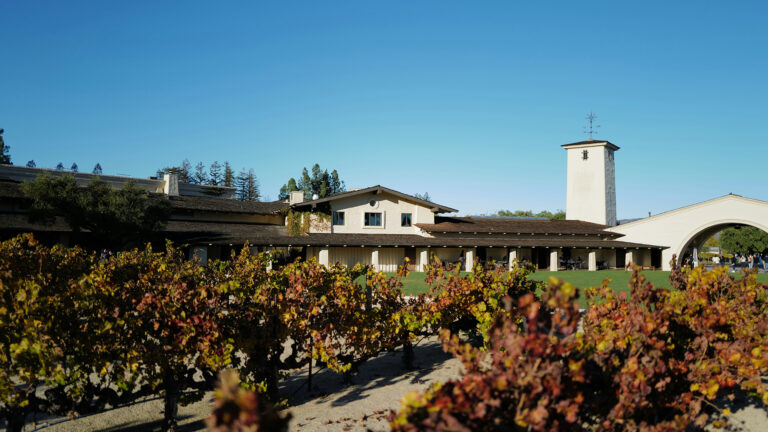Watch the video here:
Listen on Spotify
Marc Gauthier, Concordia University’s corporate treasurer and chief investment officer, has built an “investment playbook’ that removes beta from its pension plan and an impact-driven strategy for its intergenerational fund. In this interview, he outlines his career journey to his current role and how he developed such distinctive investment frameworks to meet the university’s evolving needs.
📅 Note: Gauthier will be presented with the Markets Group Strategy Award during the 4th Annual Canada West Institutional Forum in Vancouver, B.C., on Oct. 22. Register now for the event.
Lauren Bailey: Marc, welcome and thank you for being here and sharing your journey and insights. I want to first dive into your path to the CIO role because yours wasn’t the traditional route. Could you please walk us through your career journey and just share a little bit of what led you to this current position?
Marc Gauthier: Yes, you’re right. It is unusual. I came in as a university student with no money. I had to study at night, and I had three jobs during the day. In the first semester, I was then hired full-time through a restaurant position at the university. That allowed me to fund my university and then really focus on starting a professional career at Concordia. At Concordia, I just had a thirst and established a reputation for taking on major challenges and tasks at the university and turning them around. That led me to have the opportunity to build what was then the foundation — now, rebranded to the Intergenerational Fund — from the bottom up, first as an accountant, but then as a financialist, and then eventually as a CIO.
It eventually led me to take over the pension fund, which was pretty much while the financial market of the 2008 crisis occurred and when the pension fund really went from being 105% funded to 74% funded. Essentially, my thirst for just taking on a chaotic environment — a challenging environment — and just enjoying it and then turning it around is what led me to be an accountant and ending up being a CIO.
Lauren Bailey: You walked its halls, you started your career there. How has this shaped your investment philosophy and your approach to stewardship?
Marc Gauthier: When your background is both corporate finance and risk management, you essentially are concerned in managing the whole of the balance sheet of the university. When this happens, you tend then to orient your investment approach from a balance sheet perspective, mostly from a liability and a cost perspective. In that context, when you manage a balance sheet, it’s about affordability and it’s about optimization, all framed against fiscal discipline in the context that you want to make sure that you have fiscal capacity at all times for the university. You’re thinking intergenerational already from that perspective.
That’s why, in thinking of building up the investment approach, it was really in the context of seeking to be all weather, irrelevant of what noises occur during the year or new noises, and so that this way it is really made to surpass all kinds of situation and challenges. Also, in risk management, you always have the duality of balancing risk appetite and risk tolerance. In the university context, it’s definitely a risk tolerance environment because the operational margins are so tight they cannot afford volatility. That’s hence the reason why the approach was all-weather.
It was specifically the objective to preserve capital at all cost because that’s the number one risk against volatility, and affordability is the loss of capital. It was built to preserve capital at all costs, compounding all the time, the returns, and then combine that with a bit of risk appetite and make sure that you have the skill to meet your strategic target. It’s really a balance between risk appetite and risk tolerance in the context of making sure that it’s affordable throughout multiple periods.
Lauren Bailey: Both of these funds have distinct mandates. Could you please explain how this dual fund structure came about with these different mandates?
Marc Gauthier: For the pension plan, it’s a defined-benefit plan. They’re rare now. The reason why they are rare in the market, and I think that’s a strategic advantage for the university, is because of the funding challenges. Then it’s compounding now, thinking about just the market aspect of volatility. There’s also now longevity, and that comes into effect in the pension plan context. We often refer to ourselves in the DB context, we’re long-term investors, but we’re short-term funders. That’s the reality. Then we go back again to that notion about the objective of affordability.
That’s why we built a funding policy. Before even thinking about the investment policy, we built a funding policy, which really establish two major objectives. Affordability and intergenerational equity. What this means, essentially, is stability in cost. In order to do that, we designed an overall allocation that is all absolute return-driven and not relative to the market. It’s cash-plus thinking. That was how the influence happened for the pension plan. For the Intergenerational Fund, it’s purely a strategic approach. The university wants to be a leader in sustainability through all of its program, whether it’s academic, research.
In my case, I want to make sure that our sector finances reflect that from both a financing perspective and an investment perspective. Our then foundation got rebranded to the intergenerational equity. Not only to reflect the objective to secure the university’s financial aid over the long term, but doing so in an approach where it’s 100% impact-oriented. It’s all about intentionality. It’s all about finding solutions. In this way, in this context, what we look for is to first address any capital allocation with a purpose, and then matching that to the ability to meet our strategic target financially.
Lauren Bailey: It’s so interesting. I just want to separate the two for a minute and dive a little bit deeper into both, starting with the pension plan. You’ve designed this framework to, as we said before, just disassociate beta.
Marc Gauthier: For the pension plan, essentially, there’s a few elements in designing an allocation that is all-weather and has the objective to preserve capital, but still have the ability to take on risk and meet a strategic target. One is I call that outsourcing or rebalancing. In most plans, you have this automatic rebalancing of your asset classes. In our case, we don’t allocate capital by asset classes. We allocate by funding objective, strategic objective. For the pension plan, I mentioned the affordability and intergenerational equity goals. The way we designed it is really, I’m a football guy, I love football, so it’s offense, defense, special teams.
Defense is not your traditional defense that one would think of, which is long-only bonds. It’s all dynamic, unconstrained mandates. Often, it’s multi-strats. What ended up happening here is that this is almost 40%, it used to be 50% of allocation. These are all dynamic asset allocations. What they are essentially doing is outsourcing, rebalancing because they are so dynamic. They’ll do the rebalancing for you, depending where the market is going, to make sure that you preserve capital. Then, of course, take on the ability to do a risk-on movement if that is where the market is going. That’s how we build the capital.
The whole capital preservation aspect is really, to me, is we outsourced the whole rebalancing into a significant account of our allocation toward dynamic, unconstrained mandates. That’s one. Two, then private markets, we’re about 40%, I would say, of allocation, between 40% and 50%, but it’s super, super diversified. You get your private equity and your venture capital, but they are geographically focused on the major economies. Then you have all kinds of thematics that we have as well as part of the special teams, which is in life sciences, what I call LDI 3.0, longevity-driven investment. We take that LDI aspect into account. We get real estate. We get natural resources, which take into account commodities, infrastructure, and then agriculture from many perspectives.
Then we also have what we call alternative private equity and private credit. We were looking at different ways of using credit. Credit could be, for example, litigation financing. It’s a different way. Alternative private equity is like having GP stakes. In one bucket, you have the LP where you’re paying fees. The other bucket, you have GPs where you’re collecting fees. Put it all together, it’s highly, highly diversified. There’s very little risk concentration. That’s what has been really the success in making sure that we never lose capital, which we haven’t in the last 10 years. We only use long only for proxies to maintain coverage and then liquidity, which is probably between 10% and 15%.
Lauren Bailey: I love the sports analogy because it really can transfer to just about anything. I want to shift a little bit to the Intergenerational Fund now because, as you’ve said, every single allocation has an intentionality behind it. Knowing that, where are you focusing? Where is that intentionality focused?
Marc Gauthier: The Intergenerational Fund, that was very interesting. I call it a three-dimensional governance structure. You got the boards, which got to make sure that they’re focused on meeting the strategic financial targets. You got a community who’s focused on solving the world’s issues. The universities also have its own view and strategic orientation in terms of building up, in attacking sustainability. What we end up doing is we designed this three-dimensional capital allocation process. For the board, obviously, it’s based on asset classes. For the university, it’s based on UN SDG goals. We want to make sure that we’re scoping all 17, which also is part of intentionality.
Specifically, to answer your question about where is the intentionality, it’s based on a capital allocation framework that has three main sustainable asset classes. One is planet. The other one, people, and sustainable economies. Then you have these sub-classes. For example, on the planet side, we have decarbonization. We’ve got biodiversity. We’ve got a circular economy, for example.
For the people, we’ve got equity, security, and health. For the sustainable economy, we’ve got supply chain, good actors, and technology. Then we associate UN SDG themes to each of these subclasses, and that’s how the two came about. Whenever we source opportunities, we first source on intentionality with the objective to be as much scoping our capital to find as much as possible in place to many solutions. Then we marry this to our asset classes, where we may meet our risk-adjusted return target.
Lauren Bailey: Is this where you can have a little bit more of an expansive view?
Marc Gauthier: The second you add this level of vocation towards your sourcing and due diligence, it has a whole new dimension that is really quite interesting. In fact, I can also speak to my team, I’m quite proud in terms of looking at really trying to solve and be part of solutions. I do mention that we also have at least 10% of allocation, what we call mission-related investments, where they’re really specific to universities. This is our CDPQ equivalent of investing locally, but specifically here, it’s not just local, it’s about the university’s specific mission that they want to address.
You’re thinking about this differently because when you source for capital, you look now for, okay, is there conviction in the strategy? In other words, what’s the breadth and depth of their strategies in relation to the intentionality? How much influence do they have to make sure that this is just not an allocation process, that they will influence the depth and breadth of the intentionality? Then, of course, there’s all the integration of engagement, and what else can we do to even complement it? It’s a really different way of approaching due diligence and sourcing.
Lauren Bailey: I know through this fund, the Intergenerational Fund, you do have some allocations toward Africa. Where are you deploying capital specifically in that region? How do you gauge its growth potential?
Marc Gauthier: Yes. Africa, it’s both a strategic allocation for the Intergenerational Fund as well as part of the overall objective of intentionality. What I mean by that is Africa will eventually represent about 40% of the world’s youth. Therefore, for our next generation of students and thereafter, we need an Africa that is strong because they’ll likely be the economic motor for the world. If it goes well, then we got a chance. If it doesn’t, then this is where the challenges will even be more than what we have today. The problem there is that the demographic is outpacing the economy.
What we’re trying to do here is we’re trying to allocate capital where we can seek to be part of the solution in addressing how can we both match their growth in the economy and then the demographics. The reality of Africa is that they have all the resources to be self-sufficient. Everything is there. To answer your question specifically, one, we have an allocation. It’s really a strategic allocation, not from an equity perspective, it’s from a loan perspective, to help an entity that has the sole purpose to create jobs for youth and women through a trading platform because 90% of the economy in Africa is small businesses.
Complement with accessible and affordable financing to this, and as well, an education of how to go about managing a business. We’re there to support the working capital to make sure that this small VC will grow and then be self-sufficient. We’re the first institutional investor. We are the first investor in there to provide capital. Not even Africa provided by capital. It’s a bit weird that the Canadian is one that actually supported, were the first one to take risk from a creditor perspective, not even the Africans.
That’s our conviction to go that way. We also invested into electricity, to provide electricity with a new form of, it’s like a depanneur to recharge your all electricity needs this way. It’s a portable way. We also invested in students. It’s called Bright Investment. We’re essentially providing the ability for African students to get an education. Then finally, we’re looking now to do our own set of macro loans to recruit international students to provide not only the ability to get access to our education, but as well, supporting them in overall career thereafter.
Lauren Bailey: It’s really just amazing what you’ve done with that Intergenerational Fund and just working in different allocations and regions and missions all in one. What advice can you offer your peers who may also be facing similar pressures to increase focus on certain ESG issues while keeping in mind that risk management priorities need to be maintained and even top of mind?
Marc Gauthier: I have a very engaging community at the university, which is a good thing. It requires a lot of effort, obviously. In dialoguing with your community, you’ve got this inherent conflict with your community. They have an urgency. They want to fix the problem now. Of course, with investments, you have a long-term view. There’s an inherent conflict to this. The idea is, again, to take that three-dimensional aspect. You want to make them aware of the challenges and the objective, and how to approach investment, but you also want to listen to them as well. Then you figure out, and then you have the university as well in the middle, that’s why the three-dimensional aspect. Then, at the end, what you want to do is find a solution to all. That’s how we came about the 100% intentionality aspect. What it requires is a lot of communication, perseverance, and then really to explain that we’re going to find a solution, but not in the way they’re thinking, in a way that is aligned to investments. At the end, you really want, once you have this, to further continue dialogue with constant communication about, one, being transparent, and then, two, most importantly, tell the story with what you did with the capital and how much it is impacting. It’s the communication part of the story, telling the story is important, but as well, find the solution to all, and then explaining it in a way that they can understand it.
Lauren Bailey: Of course, successful strategy execution depends on alignment with the board. How do you ensure clear communication so that your team and the board stays cohesive and focused on shared priorities?
Marc Gauthier: Yes, effective governance, you’re right, Lauren, it’s actually key. It’s my experience that you need to establish credibility and trust with the board. I’m an accountant by trade, and I’ve been living through these three words that you’re brainwashed with when you become an accountant: completeness, accuracy, and timeliness. That concept is not only limited to data. It also can be expanded to strategy. What I mean by that is, the breadth and depth of your strategy and your thinking, when you present it, is what will ultimately gain the trust that you put in, that the whole will be effective and efficient as a whole.
Then, after that, it’s one thing to have that, okay, you design something that has that breadth and depth, but then you have to communicate it. Then, I remember our chief communications officer at the university saying the concept of a seven-time communication. You have to make sure that you bring up the subject at least seven times to make sure that, one, they listen eventually, because sometimes, at the beginning, you don’t listen, and then, after that, to understand it. Then you have to do that seven times in different forms, different ways.
It does require an increased level of communication and engagement with your board, an increased level of communication as well, in terms of the subject matter, but also flexibility, because you want to make sure that you do take into account their feedback. As a result of this, you have something that they are a part of but as well is aligned to what you’ve done. It’s a lot of perseverance, too, but ultimately, the key is to establish that credibility and trust with them.
Lauren Bailey: Marc, thank you so much. I can’t think of a better way to end this chat. I want to thank you for joining me today. I really appreciate your candid insights. I look forward to celebrating your achievements on October 22nd at the Canada West Institutional Forum in Vancouver.
Marc Gauthier: It was most my pleasure, Lauren, and thank you so much again for the award and this interview.













